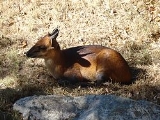
Red-flanked Duiker
Encyclopedia
The Red-flanked Duiker (Cephalophus rufilatus), is a tiny antelope
found in western and central Africa
.
Red-flanked Duikers grow to almost 15 inches (35 centimetres) in height and weigh up to 31 pounds (12 kilograms). They have a russet coat, with black legs and back and a white underbelly.
The duiker feeds on leaves
, fallen fruit
s, seed
s, flower
s, and sometimes small bird
s or other small animal
s. They have a lifespan of 10-15 years in captivity.
The wild population is estimated at 170,000 individuals.
Antelope
Antelope is a term referring to many even-toed ungulate species indigenous to various regions in Africa and Eurasia. Antelopes comprise a miscellaneous group within the family Bovidae, encompassing those old-world species that are neither cattle, sheep, buffalo, bison, nor goats...
found in western and central Africa
Africa
Africa is the world's second largest and second most populous continent, after Asia. At about 30.2 million km² including adjacent islands, it covers 6% of the Earth's total surface area and 20.4% of the total land area...
.
Red-flanked Duikers grow to almost 15 inches (35 centimetres) in height and weigh up to 31 pounds (12 kilograms). They have a russet coat, with black legs and back and a white underbelly.
The duiker feeds on leaves
Leaf
A leaf is an organ of a vascular plant, as defined in botanical terms, and in particular in plant morphology. Foliage is a mass noun that refers to leaves as a feature of plants....
, fallen fruit
Fruit
In broad terms, a fruit is a structure of a plant that contains its seeds.The term has different meanings dependent on context. In non-technical usage, such as food preparation, fruit normally means the fleshy seed-associated structures of certain plants that are sweet and edible in the raw state,...
s, seed
Seed
A seed is a small embryonic plant enclosed in a covering called the seed coat, usually with some stored food. It is the product of the ripened ovule of gymnosperm and angiosperm plants which occurs after fertilization and some growth within the mother plant...
s, flower
Flower
A flower, sometimes known as a bloom or blossom, is the reproductive structure found in flowering plants . The biological function of a flower is to effect reproduction, usually by providing a mechanism for the union of sperm with eggs...
s, and sometimes small bird
Bird
Birds are feathered, winged, bipedal, endothermic , egg-laying, vertebrate animals. Around 10,000 living species and 188 families makes them the most speciose class of tetrapod vertebrates. They inhabit ecosystems across the globe, from the Arctic to the Antarctic. Extant birds range in size from...
s or other small animal
Animal
Animals are a major group of multicellular, eukaryotic organisms of the kingdom Animalia or Metazoa. Their body plan eventually becomes fixed as they develop, although some undergo a process of metamorphosis later on in their life. Most animals are motile, meaning they can move spontaneously and...
s. They have a lifespan of 10-15 years in captivity.
The wild population is estimated at 170,000 individuals.

